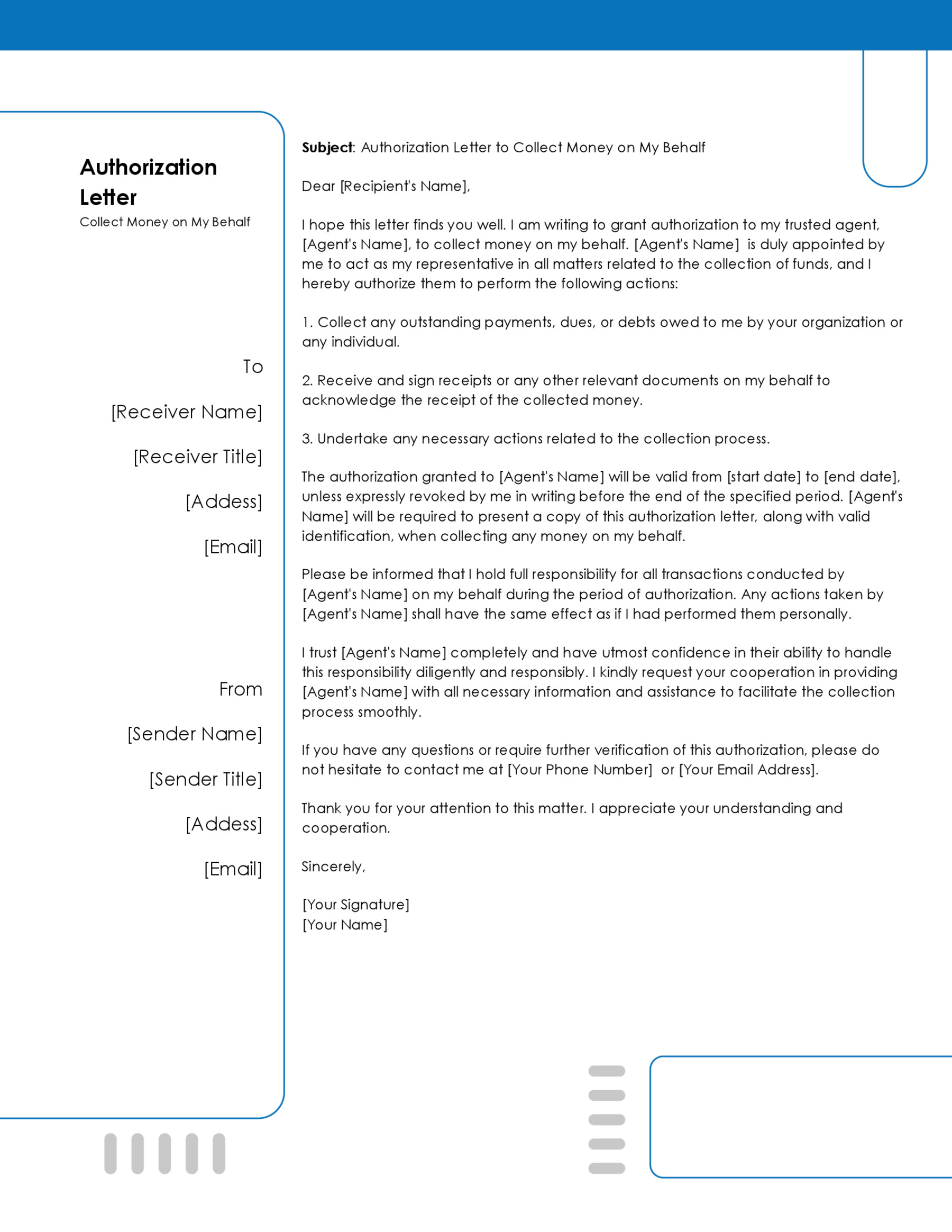An introduction letter is used by businesses to introduce themselves by highlighting the services they offer or goods they produce to potential customers, partners, distributors, investors, or others.
Such letters are used by both start-ups and established companies. It is a formal document that has been authored by the company’s official representative or owner. It creates a good first impression of the company to the investor or company, which increases the chances of a collaboration ensuing. To increase value for the company, it must outline how the service or product being offered is useful to the customers.
30 Professional Examples
Following are some free, downloadable templates for you:
Standard business introduction letter templates
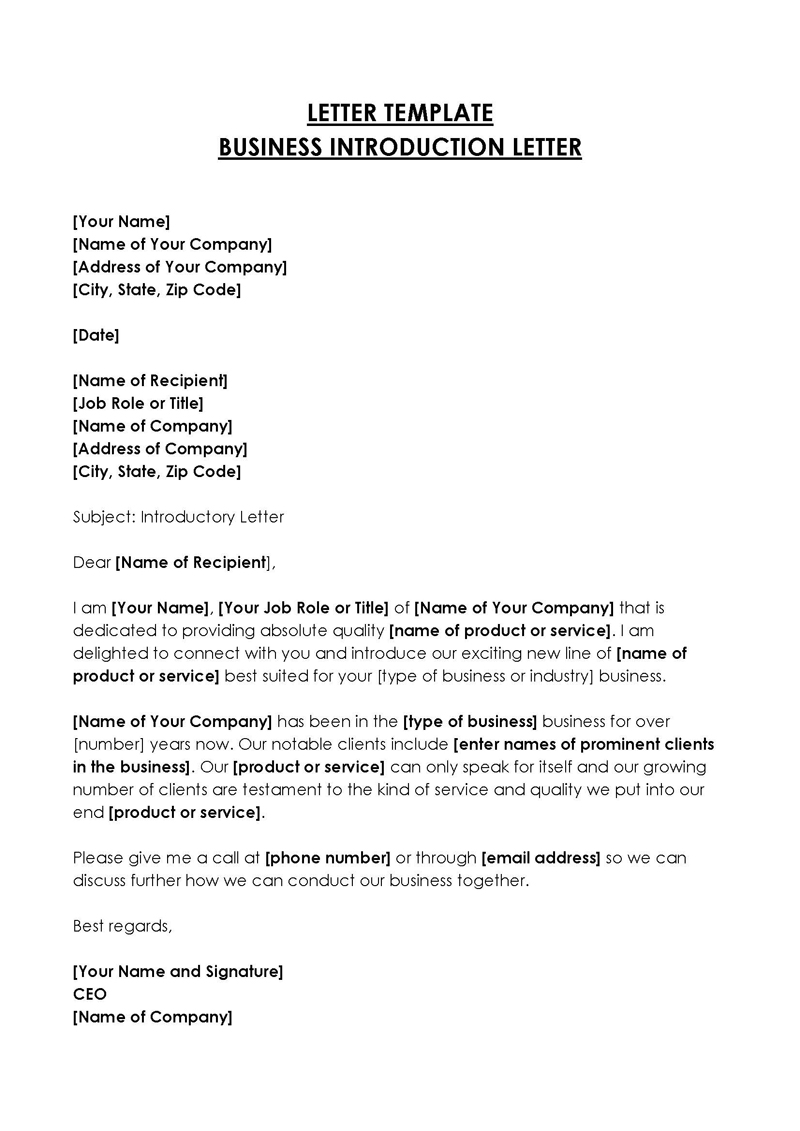
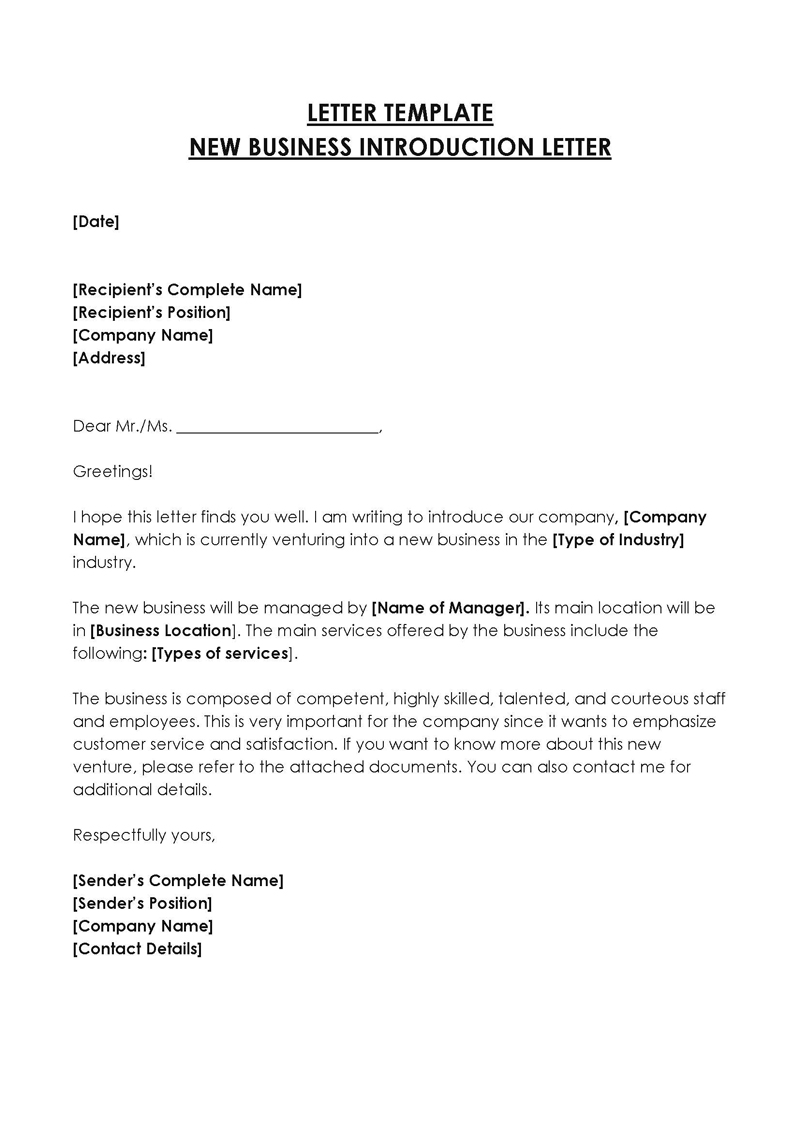
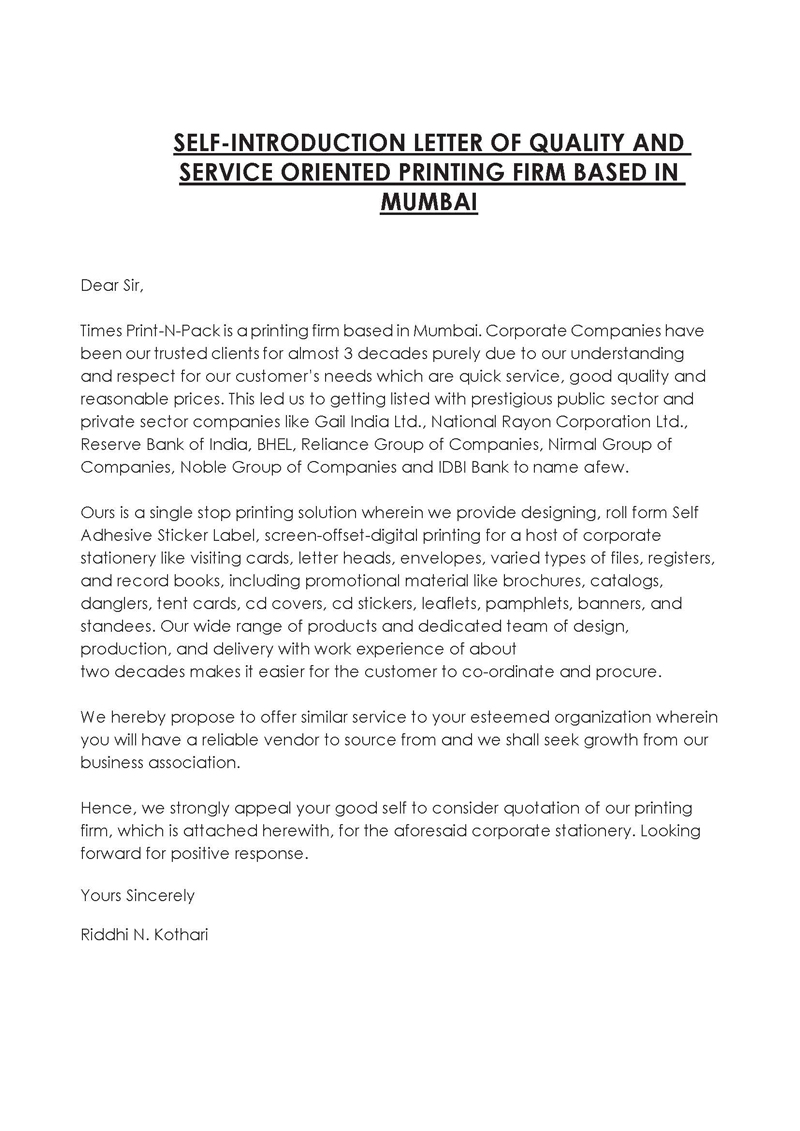
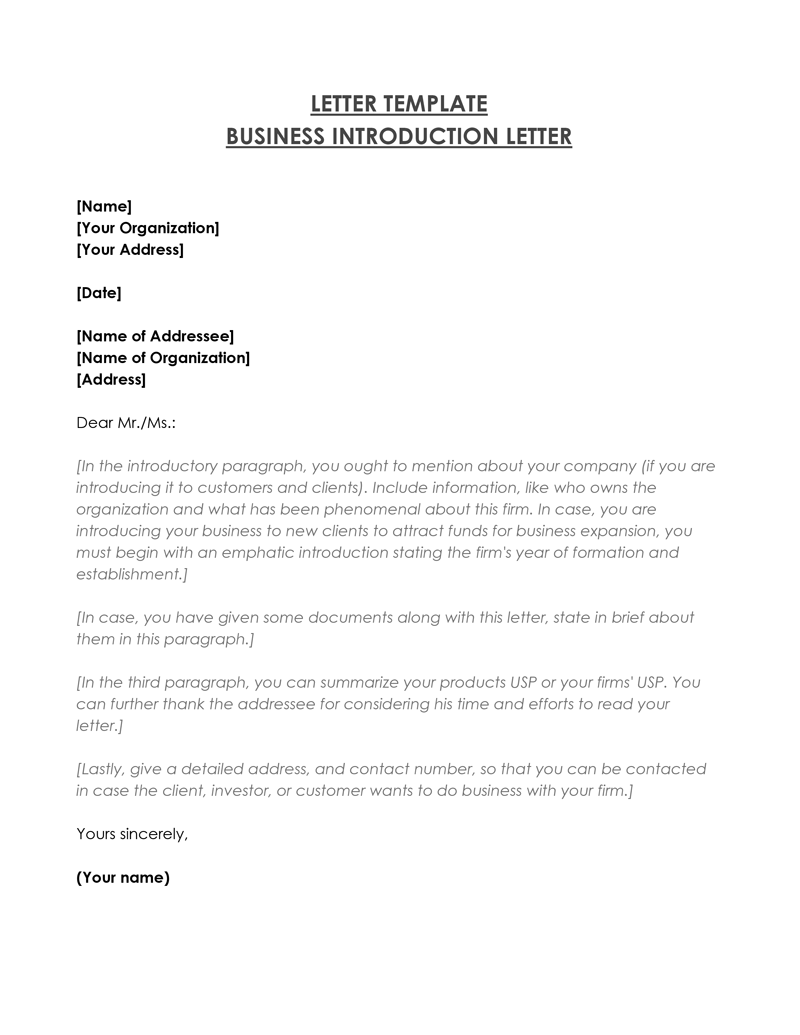
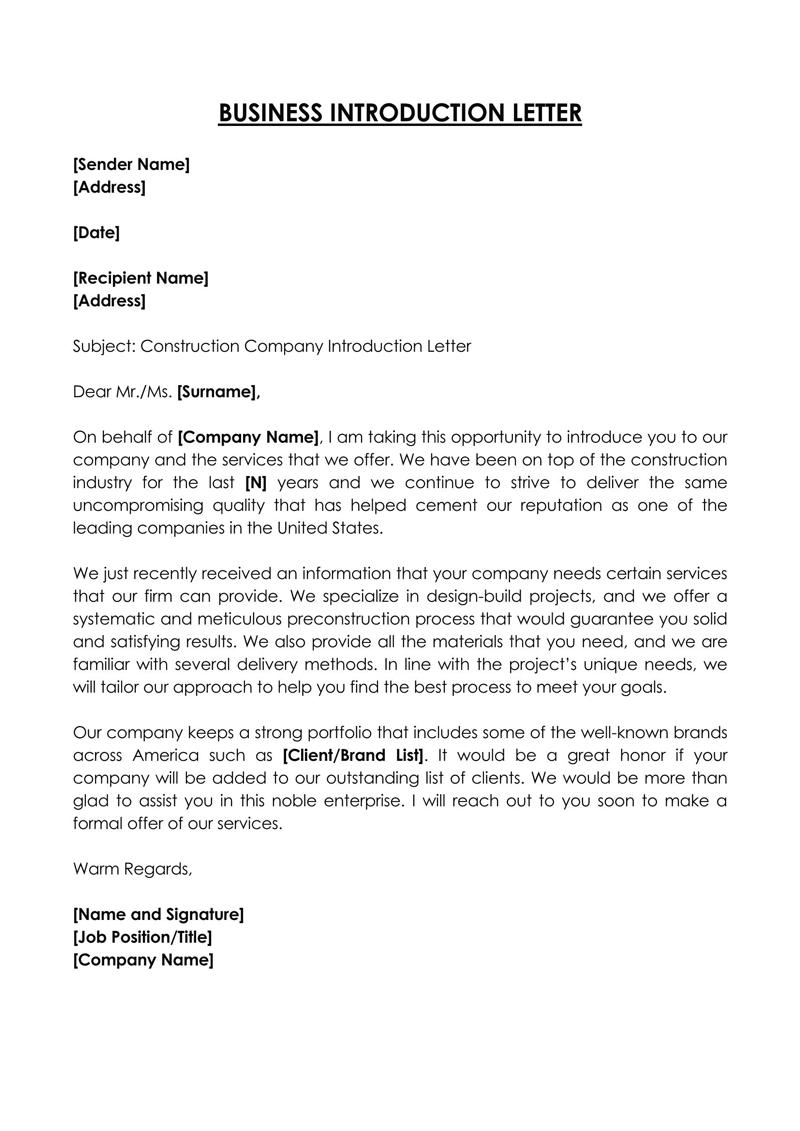
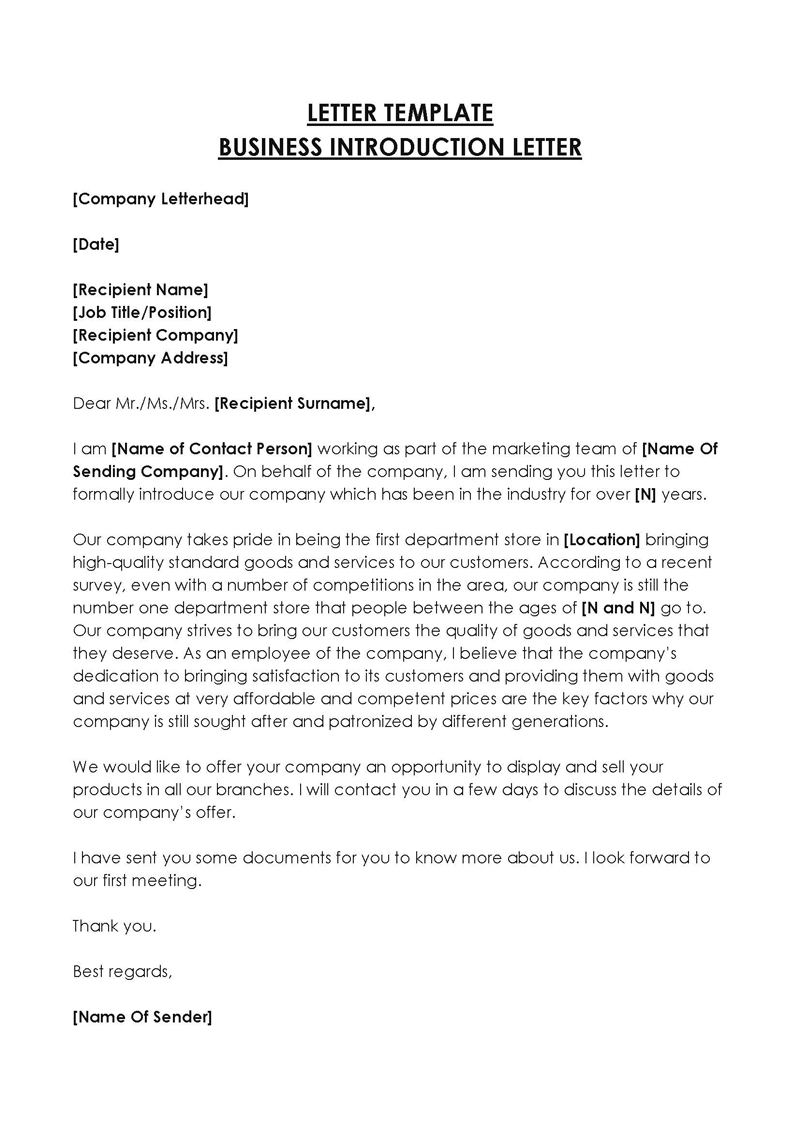
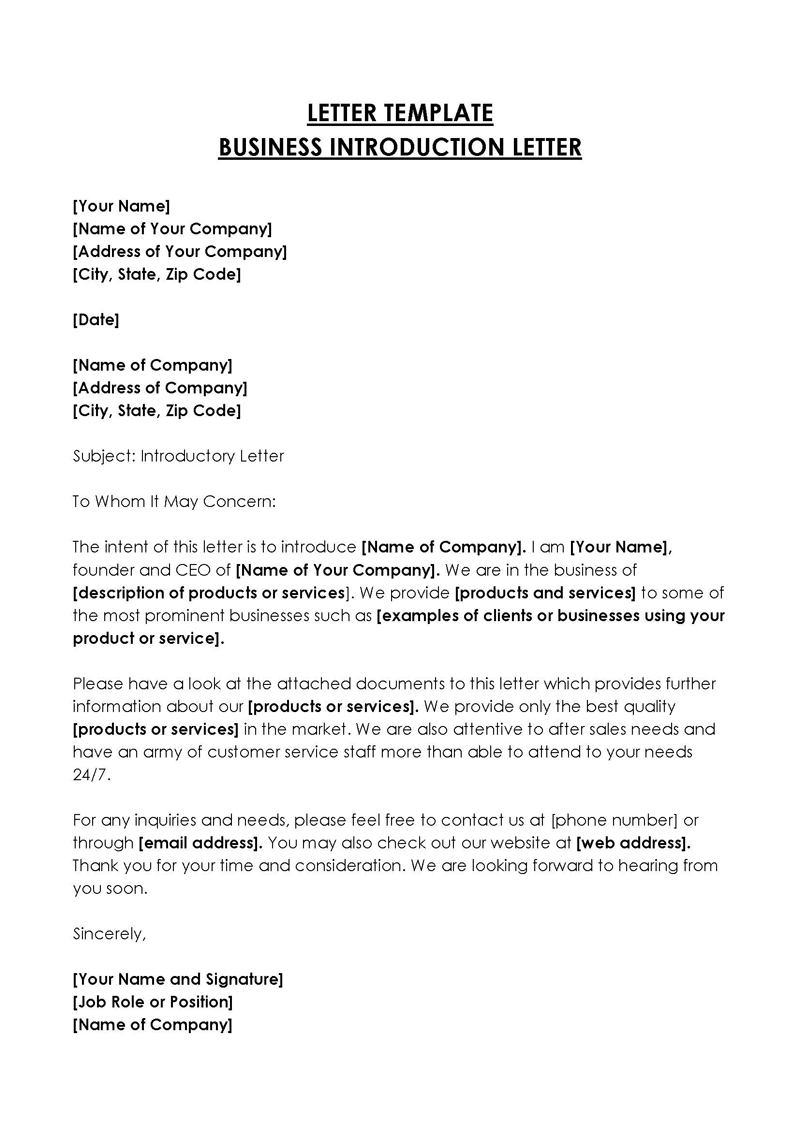
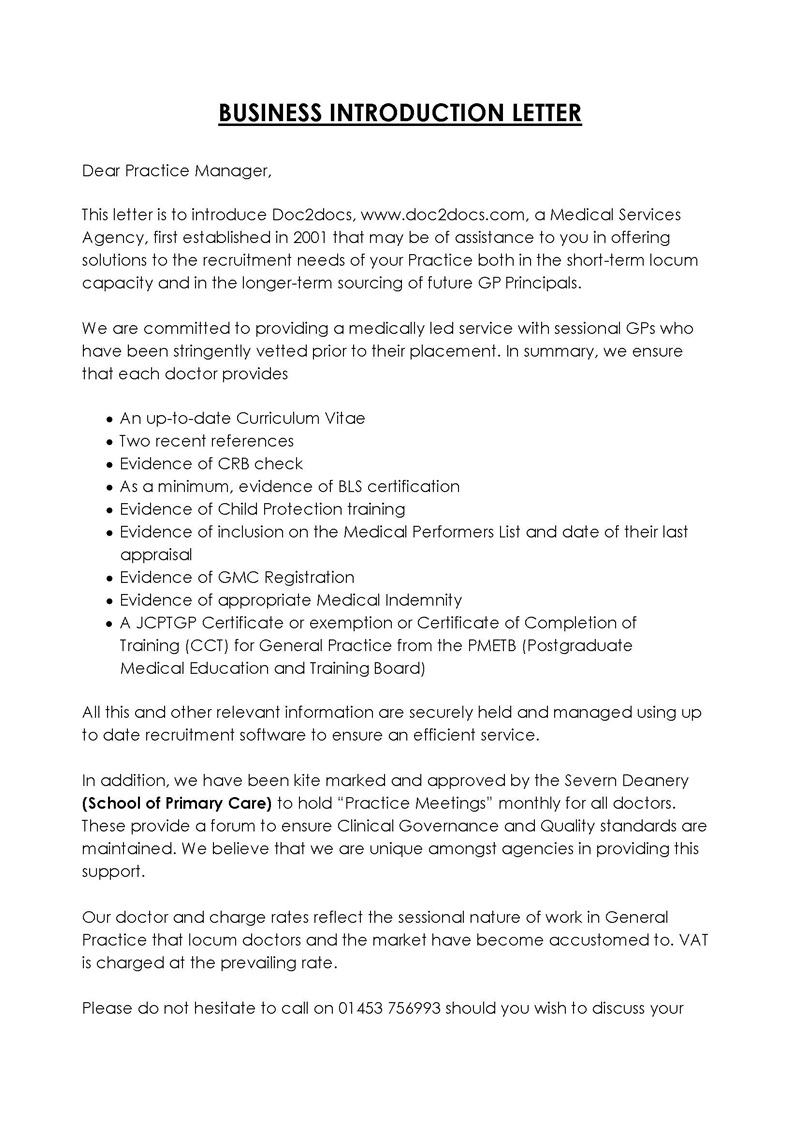
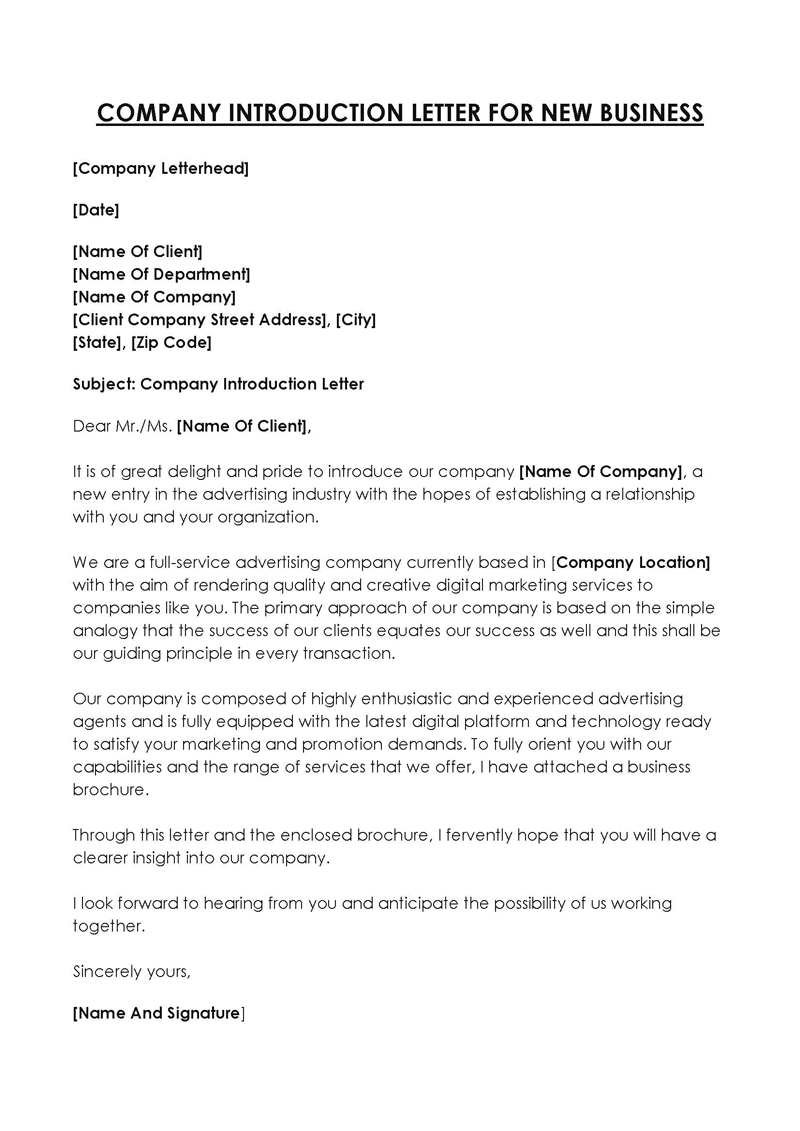
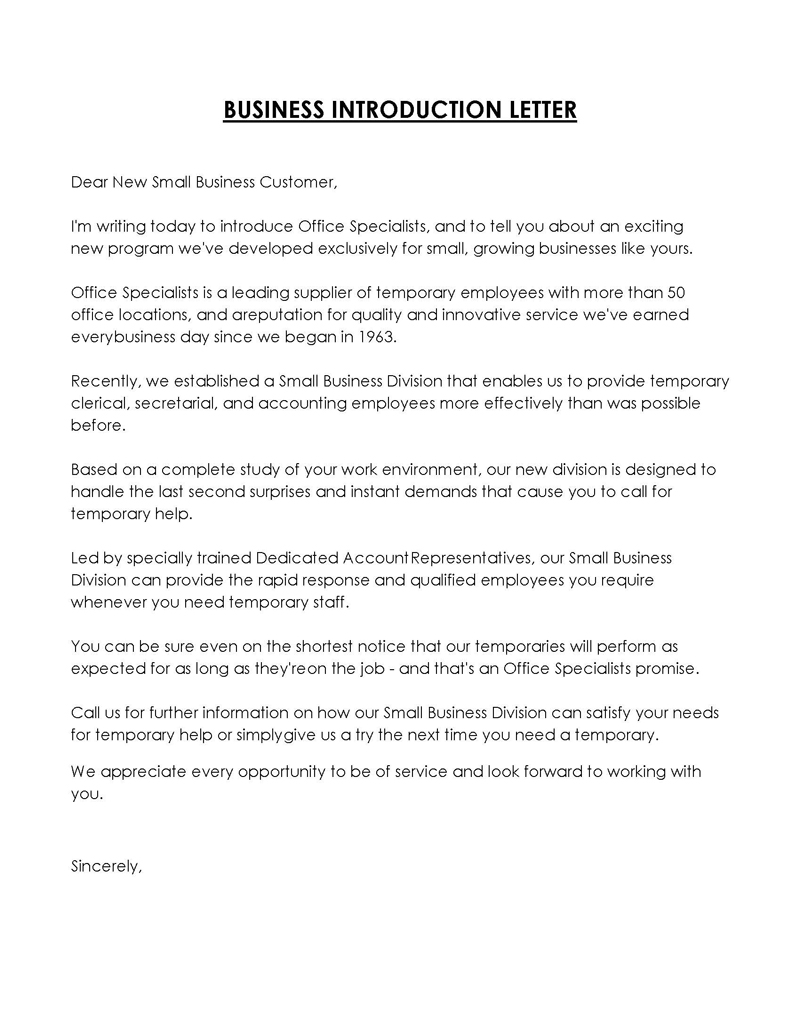
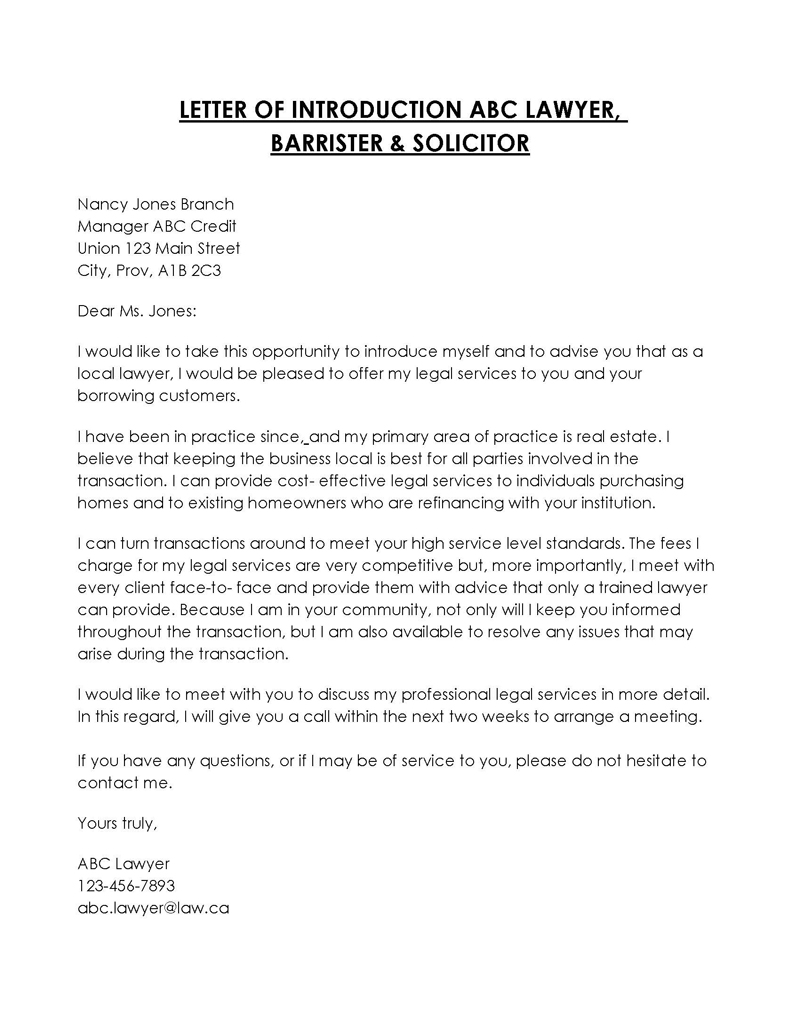
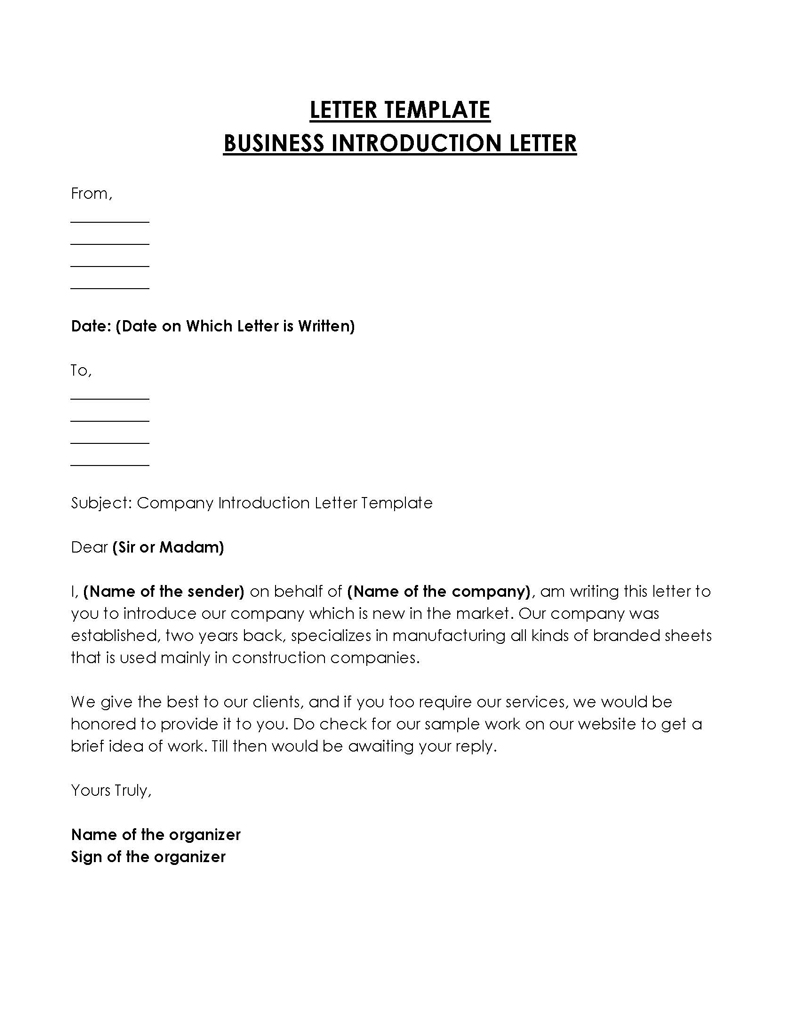
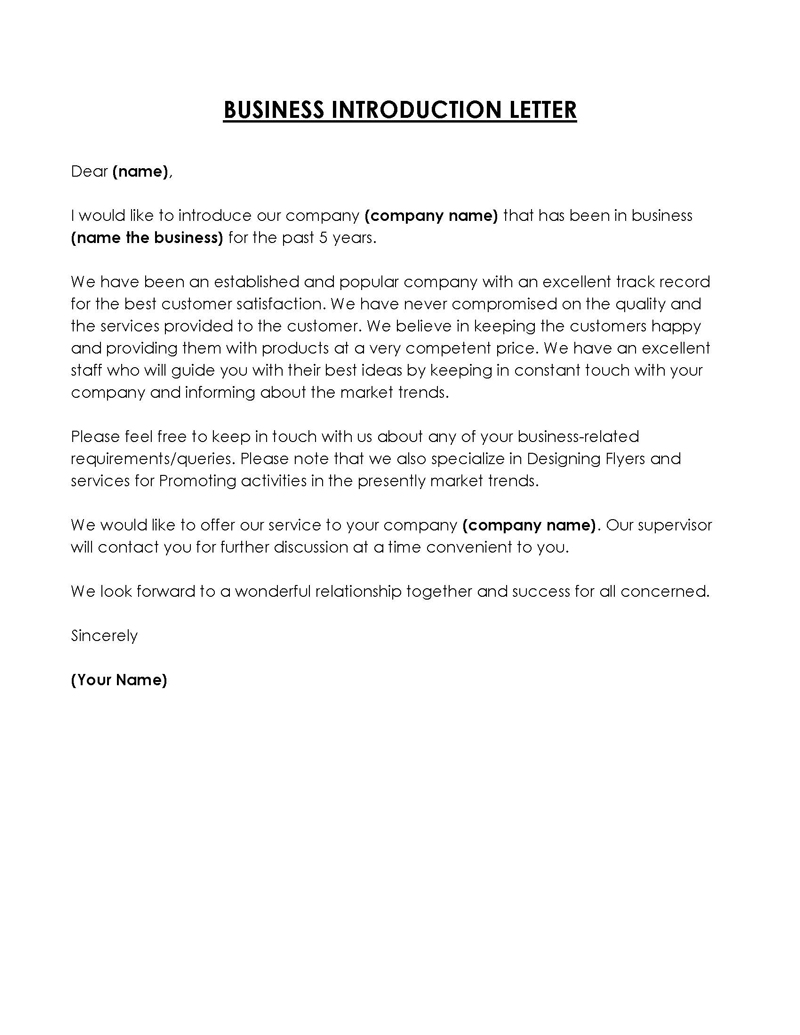
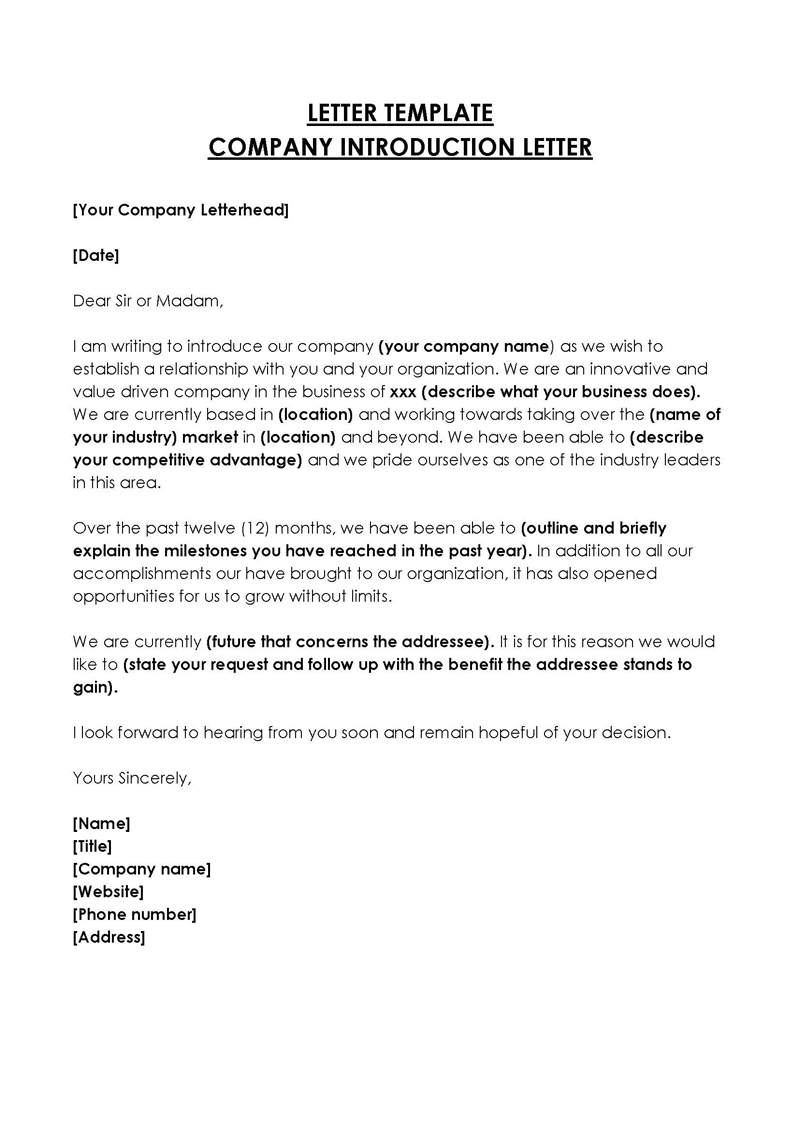
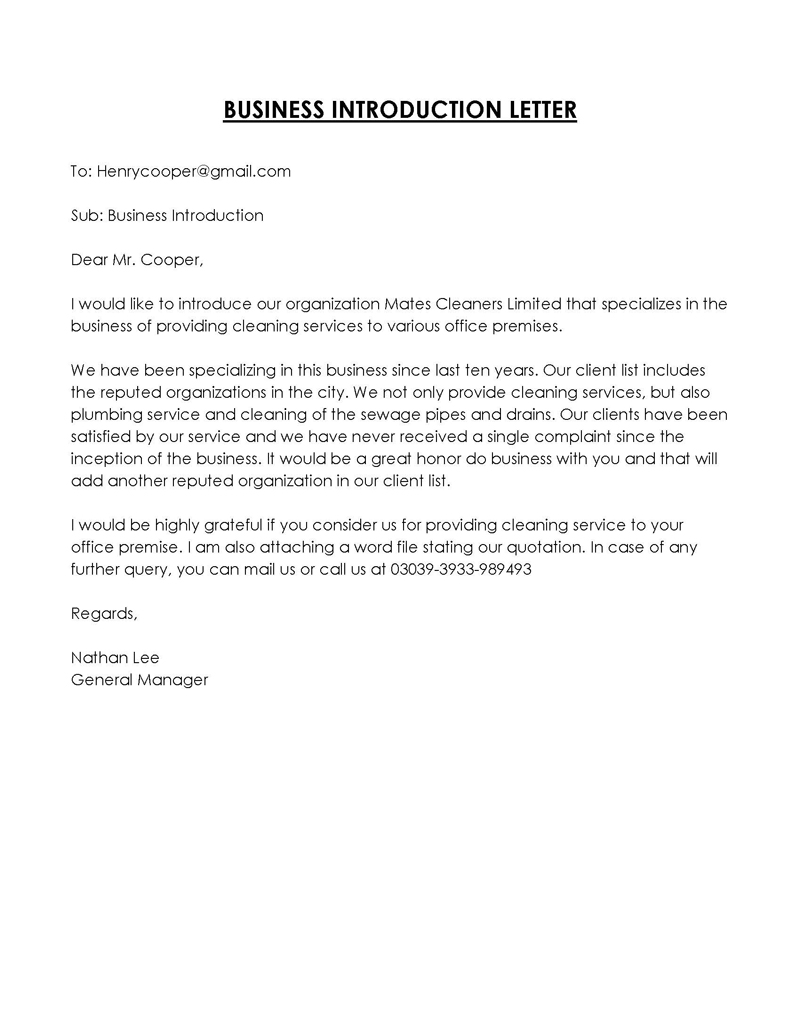
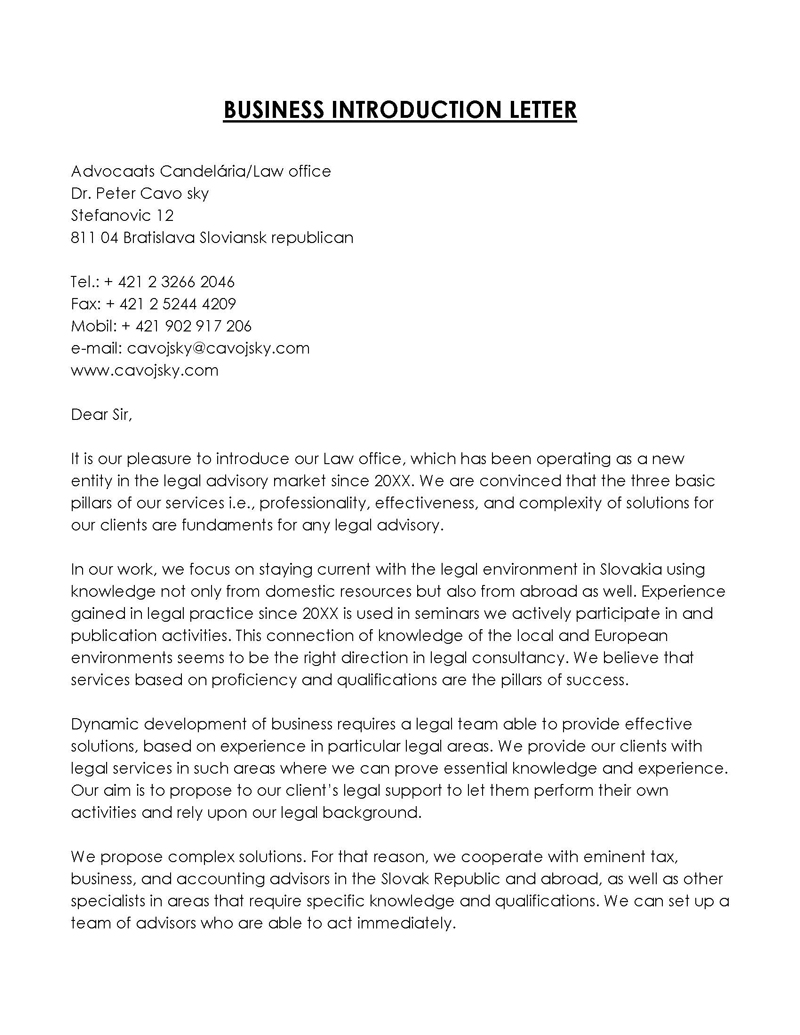
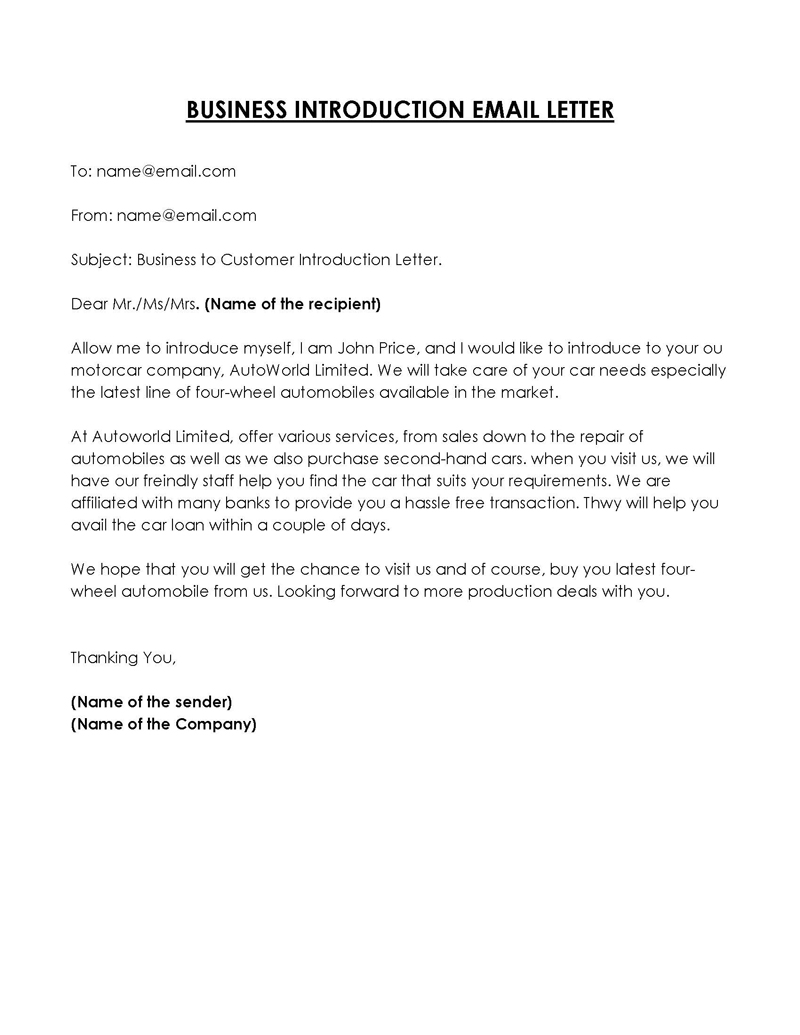
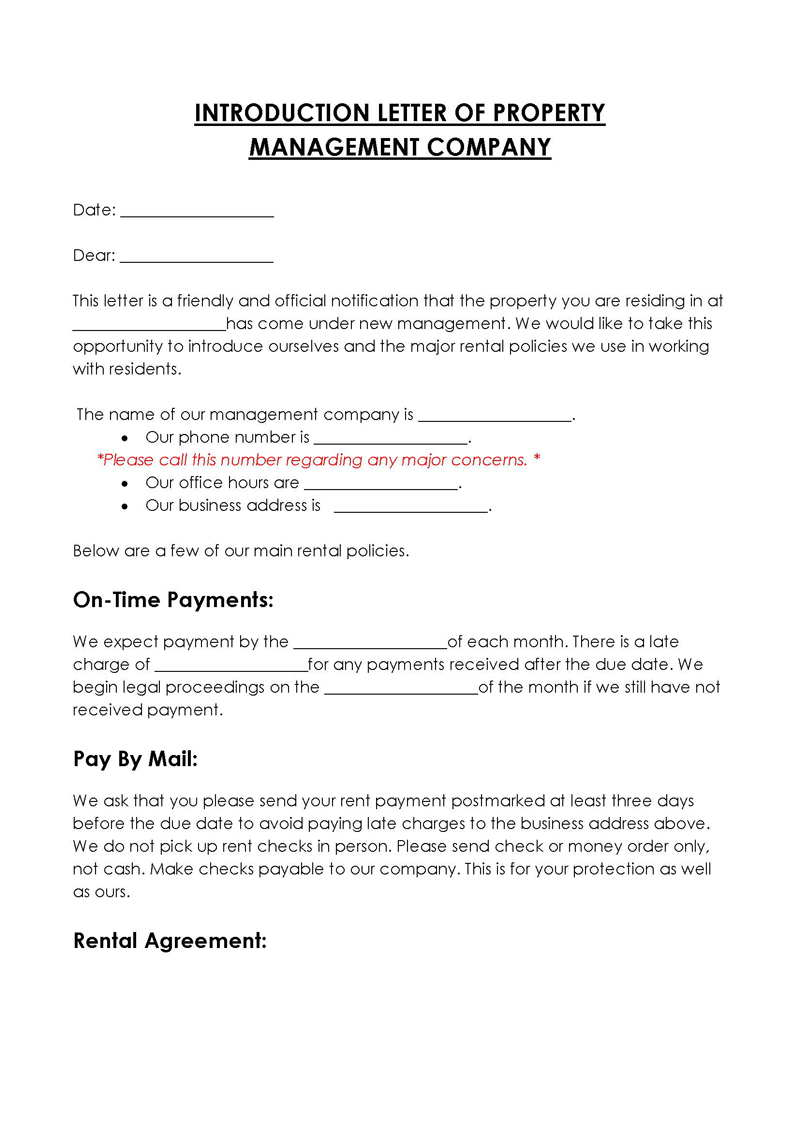
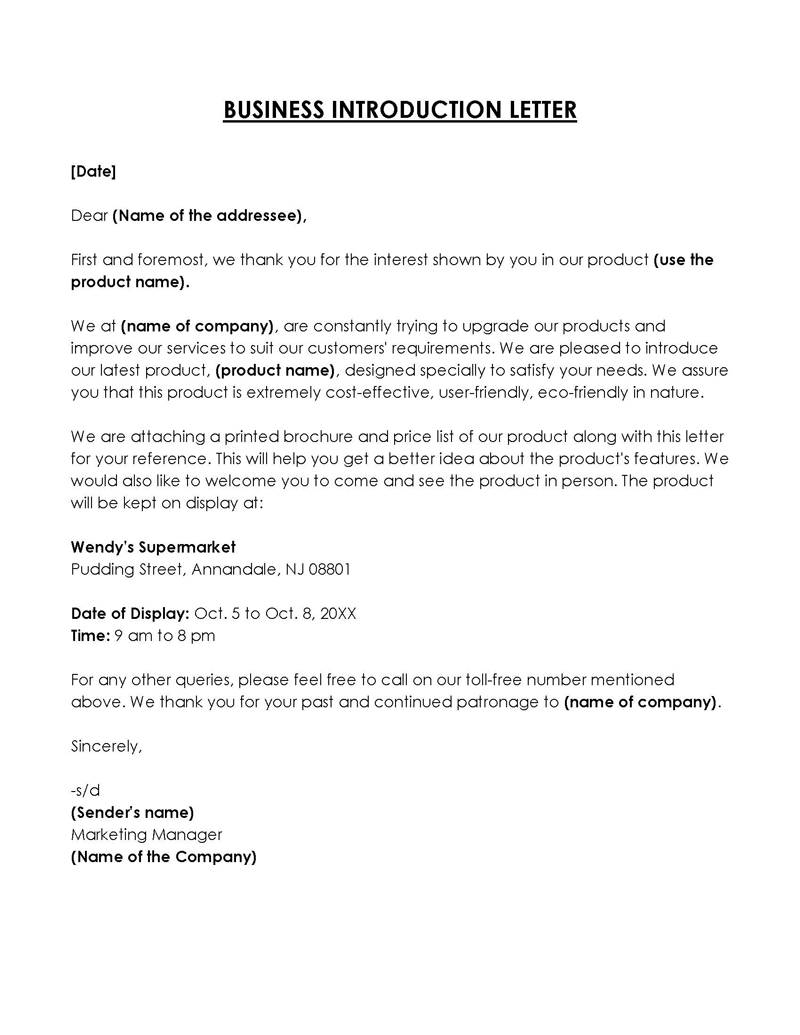
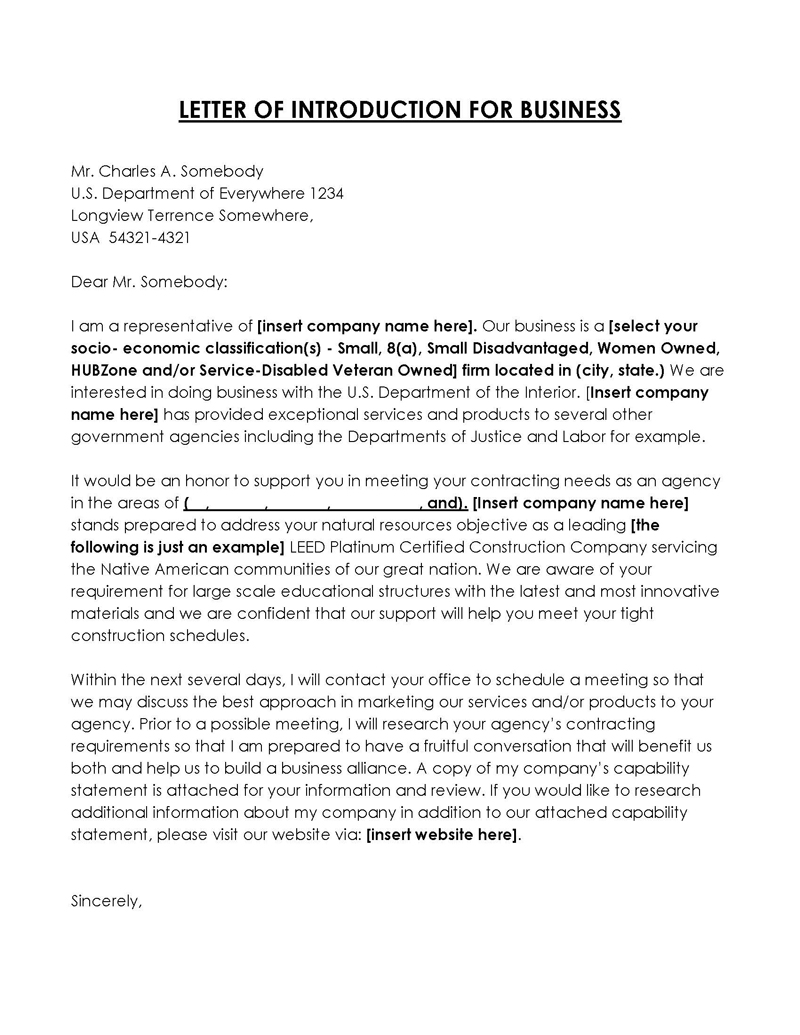
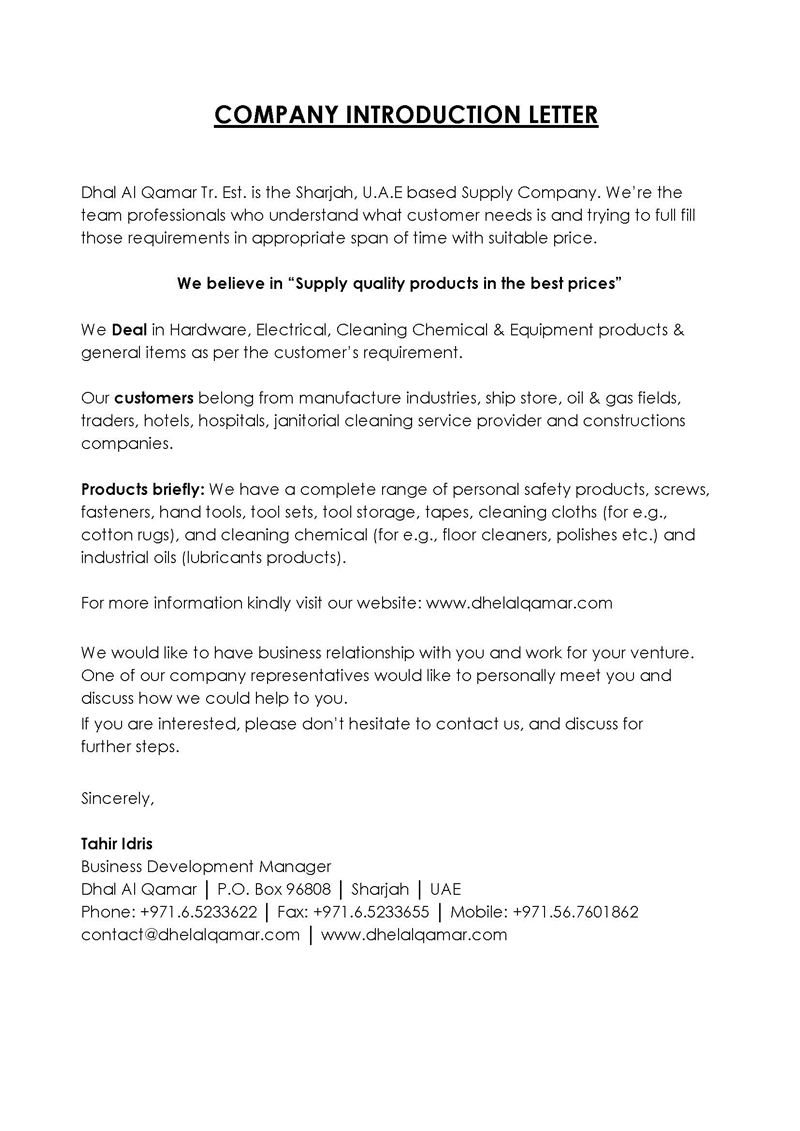
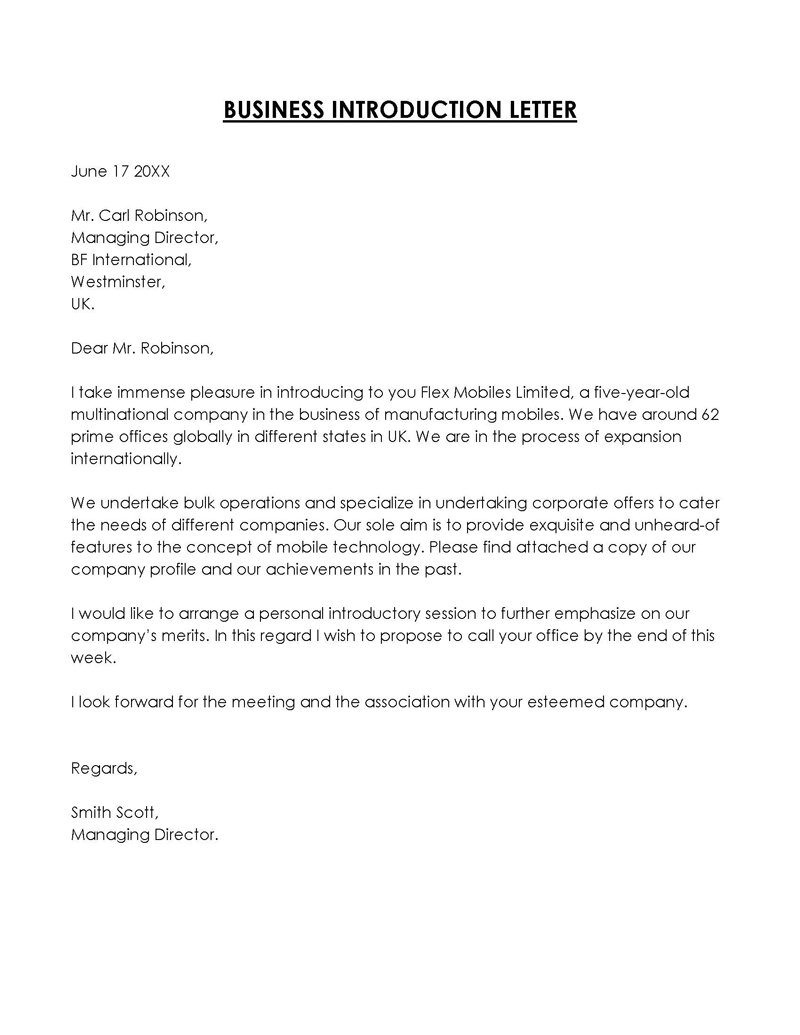
There are two common types:
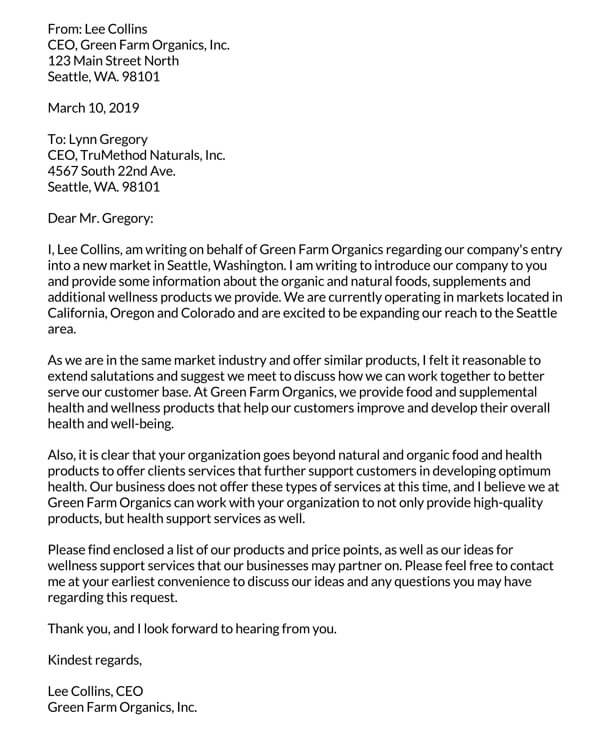
Business-to-business
A business-to-business type letter introduces the company to other businesses in an attempt to sell, buy, or partner with them. This type of letter of introduction can be used to invite other businesses to invest in a company.
Download: Microsoft Word (.docx)
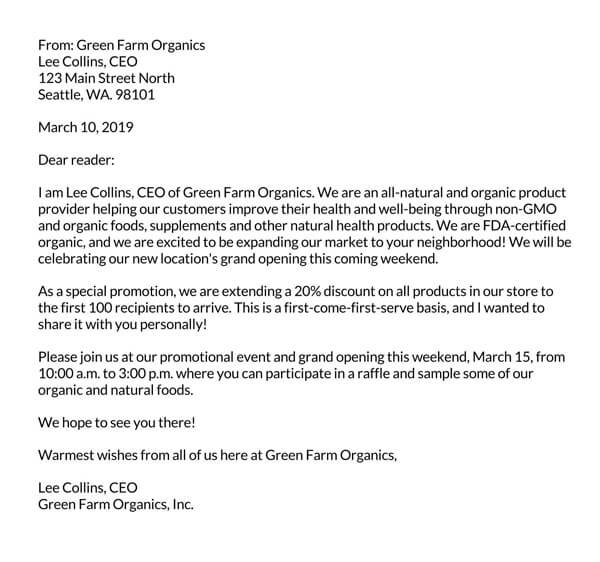
Business to Customer Introduction Letter
A business-to-customer type of letter is used to introduce the company to potential clients. It can be used to introduce a new company, new product, or a limited discount to new or existing customers.
Download: Microsoft Word (.docx)
Four Ways to Introduce Your Business
A business can introduce itself in different ways depending on who they intend to reach out to. This article will look into the four ways a business can effectively introduce its services and products to customers or other businesses.
These four ways include:
Send an introduction letter or email
A letter of introduction can be issued via mail or email. The steps followed when introducing a business through email are as follows:
Use the letterhead to introduce the company
For mail letters, after introducing the company, the author then introduces themselves by providing their name and their position in the company. In an email, state the company being introduced.
State the purpose of the business
The letter then states what the company does by stating its products and services and how they solve a problem. The company’s mission can be stated as achieving the same.
Get into details
The letter should then state its objective. Some letters can be for basic introductions, while others can be for greater reasons, such as seeking investments, partnerships, or any other. The objective should come out clearly.
Suggest the next steps
The letter should then be finalized by providing a well-defined way forward. This can be done by suggesting having a meeting or a conversation, maybe through a phone call. The author should provide their contact information and an invitation for a sit-down.
Launch on social media
Social media is also a viable alternative for businesses to introduce themselves. It has become the most popular means for businesses to engage with customers and other businesses. Twitter and Facebook are popularly used by businesses to engage with customers and other businesses.
A business looking to introduce itself to clients or possible partners can follow these steps:
Create a social media account
Create social media accounts using the business email. Name the account using the official business name or a name that indicates the specific company to which the account belongs.
Customize the account profile
State the purpose of the company in the “description” or “about” section. Use engaging language to do so. Select a colorful and creative photo and upload it as a profile photo. A photo of the products or services, or employees or satisfied customers can be used. Indicate the company’s location and a link to its official website.
Follow or add friends using the account
Physical stores should try to add and follow people within their locality. However, online service providers can add or follow people, irrespective of their location. More followers or friends mean more traffic to the business account. To engage with customers, opt to comment on competitors’ posts.
Give the followers and fans incentives
Incentives can be discounts or special deals for new followers or loyal fans. An example of a special deal is “buy two get one free.”
Respond to comments or messages
Interacting and engaging with followers and fans on the company’s page gives the company a human touch and attracts people to come back to its profile, increasing traffic.
Update the account regularly
Upload photos, post announcements, post special deals, and wish people good holidays to remain relevant to their followers. Post at most twice a day. Excessive uploads become monotonous over time.
Create an engaging website
Businesses can utilize websites to make themselves known to customers and other businesses.
The procedure for this is as follows:
- Identify the target audience and provide introductory information relevant to the audience. This includes the company’s background, products or services, and mission.
- Provide some context to the background information by giving a brief story that relates to establishing the company. Aspects to consider are funding, inspiration, motivation, partners, etc.
- State what makes the company unique. Use customer feedback to determine what is special about the company’s products or services.
- Keep the contents as brief but efficient as possible. Let the introduction be at most one paragraph.
- Proofread the introduction and ensure it is professionally written. Correct for any grammar, typos, spelling, punctuation mistakes, etc.
Make in-person introductions
Business introductions can also be made in person. The following steps can be followed when introducing the company to someone in person:
- Prepare a pitch that addresses how the company’s product or service solves a particular problem.
- Meet the customer, investor, or business representative. The business owner or representative should give the investor, customer, or business representative a firm handshake and make an introduction by stating their position in the business.
- Begin with a casual conversation and look out for openings within the conversation to talk business. Be positive throughout the conversation. Introduce the company and mention compelling details such as mission, impressive sales, etc.
- Enquire about the other person so that the conversation is not one-sided. Ask generic questions and avoid asking very personal questions.
- Present the 30-second elevator pitch preferably when prompted by a question like “What does your company do?” keep the pitch short; 30 seconds or shorter is enough. Long pitches can be overwhelming to the customer or investor.
- Highlight probable issues or challenges that would occur if the product did not exist. Then explain how the company addresses these issues or problems.
- Propose any actionable steps that should succeed in the meeting. This can include providing details of how the individual can access the company’s product or service in the future. Hand them a business card or phone number, shake their hand, and make concluding remarks by asking for a meet-up and/or a business card.
Format of a Business Introduction Letter
It should be formatted like any other business letter. The following aspects of the letter should be formatted as follows:
Margins
A half-inch to one-inch margin can be used on all sides of the letter.
Line spacing
It should be single-spaced for both lines and paragraphs. A blank line should be left after every paragraph.
Alignment
A semi-block alignment can be used where some details, such as contact details, salutation, and closing statement, are aligned to either the right or left side, depending on the standard format of a letter.
Font
Any font size range between 10-point and 12-point is acceptable. A standard font, like Times New Roman, should be used.
Printing specifications
The letter should be printed on unlined 8.5” x 11” paper. The sender’s and the recipient’s addresses should be made so that they both fit in a standard nine-inch envelope.
Other formats
Such letters can be formatted to match the company’s correspondence. Some companies indent paragraphs with the body of the letter. The font can also be varied to match other companies’ letters.
What to Include in a Business Introduction Letter
To craft it effectively, certain information must be presented in the document. These include:
Letter heading
The letter heading indicates the sender’s information. Provide contextual details such as the company’s name, return address, phone number, and email. The letter heading should b placed at the top left-hand corner of the page.
Date
Skip one line and write the date when the letter was written. Use the appropriate date format for the region; dd/mm/yy or mm/dd/yy.
Recipient address
After another blank line, the recipient’s address is written down. Include the recipient’s name, designation, and the company receiving the letter.
note
Remember to change the recipient’s details (name and address) and greetings if the letter is to be sent to multiple recipients. “CC” all the people receiving the same copy of the letter.
Subject
There should be a subject or “RE” line. Make sure it communicates the purpose of the letter – learn about the company.
Greeting/salutation
Use a formal and polite greeting or salutation. Use “Dear” followed by the recipient’s title, e.g., “Dr.” followed by the person’s name. In case the recipient’s name is not known, use appropriate titles such as “Dear Marketing Manager” or “Dear Managing Director.”
note
Introduction letters being addressed to groups such as boards of directors should use the group’s official name, for example, “Dear Board of Directors.”
Introduction
Supply a short introduction stating the purpose of the letter. In two sentences, state what the company does and why the introduction is being made.
Body
Expound on how the company’s products and services solve a particular problem and why the introduction is being made. Be direct and professional. Exhaustively market the company to the recipient.
Closing
Close the body of the letter with a two-sentence paragraph that sums up the introduction and thanks the reader for reviewing the letter.
Call-to-action
Suggest a meet-up or invite the client, customer, investor, or business to reach out. Provide contact information they can use for communication.
Signature
A complimentary closing should be provided before the letter can be signed. After the signature, the sender’s name should then be included. Their position in the company must also be indicated.
Enclosures
If the letter is being sent with other attached documents, it should be listed under “Enclosures.” This heading should be after the sender’s name and separated with a blank line.
Template Business Introduction Letter
[Your Name]
[Your Job Title]
[Your Company]
[Company Address]
[City, State, Zip Code]
[Email Address]
[Phone Number]
[Date]
[Recipient’s Name]
[Recipient’s Job Title]
[Recipient’s Company]
[Company Address]
[City, State, Zip Code]
Dear [Recipient’s Name],
I hope this letter finds you well. My name is [Your Name], and I am the [Your Job Title] at [Your Company]. [Your Company] specializes in [brief description of your company’s services/products]. I am reaching out to introduce our company and express our interest in exploring potential collaboration opportunities with [Recipient’s Company].
[Your Company] has been in the industry for [number of years] years, and we pride ourselves on [mention key achievements, unique selling propositions, or what sets your company apart]. Our mission is to [briefly describe your company’s mission or goals], and we have successfully [mention any significant accomplishments, partnerships, or projects].
We have taken the time to understand [Recipient’s Company] and believe that there is a great synergy between our services/products and your company’s goals, especially in the area of [mention specific area of potential collaboration]. We are particularly impressed by [mention something you admire about the recipient’s company], and we see a fantastic opportunity for both our companies to [mention potential benefits of collaboration, such as expanding market reach, enhancing product offerings, etc.].
To give you a better idea of how our collaboration could be mutually beneficial, I would like to highlight a few of our key services/products:
[Service/Product 1]: [Brief description]
[Service/Product 2]: [Brief description]
[Service/Product 3]: [Brief description]
I am keen on discussing how we can work together and would love the opportunity to schedule a meeting or a call at your earliest convenience. Please let me know your availability, and I will do my best to accommodate.
Thank you for considering this potential partnership. I am looking forward to the possibility of working together to achieve great results. Please feel free to contact me directly at [Your Phone Number] or [Your Email Address] should you have any questions or need further information.
Warm regards,
[Your Name]
[Your Job Title]
[Your Company]
[Your Contact Information]
Sample Business Introduction Letter
Dear Mr. Carter,
I hope this letter finds you in good spirits and health. My name is Alice Johnson, and I serve as the Director of Business Development at Innovatech Solutions, a leading provider of cutting-edge renewable energy technologies. I am reaching out to introduce our company and explore potential collaboration opportunities with Efficient Energy Corp, given our shared commitment to sustainability and innovation.
Innovatech Solutions has been at the forefront of the renewable energy sector for over a decade, driving significant advancements in solar and wind technology. Our mission is to empower businesses and communities to adopt sustainable energy solutions, reducing carbon footprints and fostering a healthier planet. We have partnered with numerous organizations worldwide, delivering customized solutions that enhance energy efficiency and operational sustainability.
We have closely followed Efficient Energy Corp’s remarkable journey to becoming a pioneer in energy-efficient products and services. Your dedication to promoting sustainable practices and reducing environmental impact is truly inspiring. We believe that a partnership between Innovatech Solutions and Efficient Energy Corp could lead to groundbreaking advancements in the renewable energy sector, offering comprehensive solutions that meet the growing demand for clean energy.
To illustrate how our collaboration could be mutually beneficial, I would like to highlight a few areas where Innovatech Solutions excels:
- Solar Panel Technology: Our state-of-the-art solar panels offer unparalleled efficiency and durability, making them ideal for both residential and commercial applications.
- Wind Turbine Solutions: We provide innovative small to medium-scale wind turbines designed for low wind conditions, significantly expanding the viability of wind energy in diverse settings.
- Energy Efficiency Consulting: Our team of experts works closely with clients to identify and implement energy-saving measures, reducing costs and environmental impact.
I am eager to discuss how Innovatech Solutions and Efficient Energy Corp can collaborate to further our mutual goals of promoting sustainable energy solutions. I would greatly appreciate the opportunity to schedule a meeting or a call at your convenience to explore potential synergies and discuss how we can work together towards a greener future.
Thank you for considering this exciting opportunity. I look forward to the possibility of our companies joining forces to make a significant impact in the renewable energy landscape. Please feel free to contact me directly at 555-987-6543 or via email at alice.johnson@innovatechsolutions.com to discuss this further.
Warmest regards,
Alice Johnson
Director of Business Development
Innovatech Solutions
alice.johnson@innovatechsolutions.com
555-987-6543
Key Takeaways
This letter effectively introduces a company and explores potential collaboration opportunities with another organization. Key elements contributing to its effectiveness include:
Introduction and Purpose: The letter begins with a courteous greeting and a clear statement of purpose, setting the tone for professional communication.
Identification and Positioning: The writer identifies their role within the company, establishing credibility and authority to discuss potential collaboration opportunities.
Company Overview: A brief overview of the company’s mission, values, and expertise is provided, giving the recipient context about the organization and its focus areas.
Alignment of Objectives: The letter emphasizes shared goals and values between the two companies, demonstrating an understanding of the recipient’s interests and priorities.
Highlight of Strengths: Specific examples of the company’s strengths and areas of expertise are highlighted, providing concrete evidence of its capabilities and potential value to the recipient.
Proactive Engagement: The writer expresses eagerness to discuss collaboration opportunities and suggests a meeting or call, demonstrating initiative and openness to dialogue.
Closing and Invitation: The letter concludes with a polite expression of gratitude and an invitation for further discussion, leaving the door open for continued communication and potential partnership.
Overall, the letter effectively communicates the company’s offerings, demonstrates an understanding of the recipient’s needs, and invites further engagement, making it a persuasive and professional communication sample.
Tips for Writing an Effective Letter
There are a few things to think about when crafting it. They include:
Be objective
First, establish the intent or purpose for writing the letter and align everything with that objective. Is it a letter to introduce a new company? New product? Make a sale? Etc. This helps you write an effective introduction letter.
Research the company or market
Find out information that can be used to come up with a personalized introduction letter. Find out the interests or needs of the client, customer, investor, or business and discuss how collaborating with the company would be beneficial or how it solves their needs.
Open with a strong statement
Have a strong opening statement that gets the reader’s attention and motivates them to read the document. Use the company’s slogan or a relevant quote.
Add only relevant details
Supply only information that satisfies the letter’s purpose and targets its audience. Irrelevant information compromises the quality of the introduction letter.
Keep it concise
Be brief and communicate exactly what is needed. A letter of 300-400 words would be sufficient to introduce a company effectively.
Proofread
Avoid submitting a letter full of spelling, grammar, punctuation errors, and typos. Instead, edit accordingly and review the letter again before sending it.
Final Thoughts
A letter of introduction is a formal and perfect way of letting customers, investors, and other businesses know what a company produces and/or offers. An introduction can be made via a letter, email, social media, website, or in person.
Introductions made to customers are known as business-to-customer introductions, while those made to businesses are known as business-to-business introductions.
An introduction should give enough details of how a company/business solves a problem or is useful to a particular market. Such letters must be written in a business format. Templates can be used to craft it effectively.



